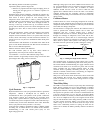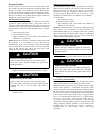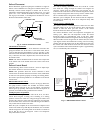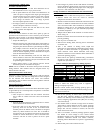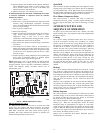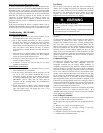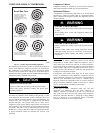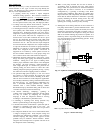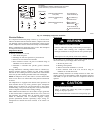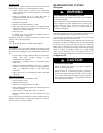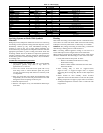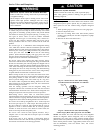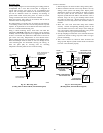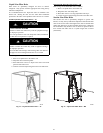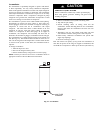
21
POWER OFF!
OHMMETER
0-10Ω SCALE
5.2Ω
0.6Ω
5.8Ω
DEDUCTION:
(EXAMPLE)
TO DETERMINE INTERNAL CONNECTIONS OF SINGLE-
PHASE MOTORS (C,S,R) EXCEPT SHADED-POLE
?
?
?
1
2
2
3
1
3
12
32
1 3 (GREATEST RESISTANCE)
5.8Ω (OHM)
(SMALLEST RESISTANCE)
0.6Ω
(REMAINING RESISTANCE)
5.2Ω
2
2
3
1
IS COMMON (C)
BY ELIMINATION
IS COMMON,
THEREFORE, IS
START WINDING (S)
RUN WINDING (R)
START WINDING (S)
IS RUN WINDING (R)
A88344
Fig. 14 – Identifying Compressor Terminals
Electrical Failures
The compressor mechanical pump is driven by an electric motor
within its hermetic shell. In electrical failures, compressor does not
run although external electrical and mechanical systems appear
normal. Compressor must be checked electrically for abnormalities.
Before troubleshooting compressor motor, review this description
of compressor motor terminal identification.
Single--Phase
Motors
To identify terminals C, S, and R:
1. Turn off all unit power.
2. Discharge run and start capacitors to prevent shock.
3. Remove all wires from motor terminals.
4. Read resistance between all pairs of terminals using an
ohmmeter on 0--10 ohm scale.
5. Determine 2 terminals that provide greatest resistance
reading.
Through elimination, remaining terminal must be common (C).
Greatest resistance between common (C) and another terminal
indicates the start winding because it has more turns. This terminal
is the start (S). The remaining terminal will be run winding (R).
NOTE: If compressor is hot, allow time to cool and internal line
break to reset. There is an internal line break protector which must
be closed.
All compressors are equipped with internal motor protection. If
motor becomes hot for any reason, protector opens. Compressor
should always be allowed to cool and protector to close before
troubleshooting. Always turn off all power to unit and disconnect
leads at compressor terminals before taking readings.
Most common motor failures are due to either an open, grounded,
or short circuit. When a compressor fails to start or run, 3 tests can
help determine the problem. First, all possible external causes
should be eliminated, such as overloads, improper voltage,
pressure equalization, defective capacitor(s), relays, wiring, etc.
Compressor has internal line break overload, so be certain it is
closed.
Open
Circuit
UNIT PERSONAL INJURY HAZARD
Failure to follow this warning could result in personal injury.
Use caution when working near compressor terminals.
Damaged terminals have the potential to cause personal injury.
Never put face or body directly in line with terminals.
!
WARNING
To determine if any winding has a break in the internal wires and
current is unable to pass through, follow these steps:
1. Be sure all power is off.
2. Discharge all capacitors.
3. Remove wires from terminals C, S, and R.
4. Check resistance from C--R, C--S, and R--S using an
ohmmeter on 0--1000 ohm scale.
Because winding resistances are usually less than 10 ohms, each
reading appears to be approximately 0 ohm. If resistance remains at
1000 ohms, an open or break exists and compressor should be
replaced.
UNIT DAMAGE HAZARD
Failure to follow this caution may result in equipment
damage or improper operation.
Be sure internal linebreak overload isnot temporarily open.
CAUTION
!



